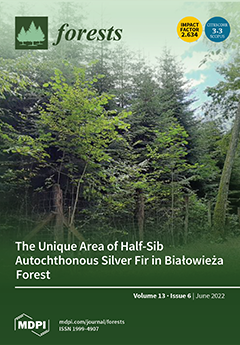This pot experiment was carried out to investigate the mechanism underlying nutrient metabolism and seedling growth responses to magnetic treatment following exposure to cadmium (Cd) stress. A magnetic device of 300 Gs was applied during Cd(NO
3)
2 solution treatment at 0 and 100 mM·L
−1. One-year-old seedlings of
Populus × euramericana ‘Neva’ were treated with different Cd(NO
3)
2 solutions in the presence or absence of magnetic treatment for 30 days. Seedling growth and physiological–biochemical indexes were measured under Cd stress. The contents of ammonium (NH
4+–N), nitrate (NO
3––N), and total nitrogen (TN) in leaves, as well as NH
4+–N and TN in roots, were increased by magnetic treatment combined with Cd stress, although the NO
3––N content was decreased. The activities of nitrate reductase (NR), nitrite reductase (NiR), glutathione reductase (GR), and glutamate synthase (GOGAT) in leaves and the activities of NR, glutamine synthetase (GS), and GOGAT in roots were stimulated by magnetic treatment; conversely, the NiR activity in roots was inhibited by magnetic effects. Magnetic treatment improved the synthesis of cysteine (Cys) and glutamine (Gln) in leaves and reduced the contents of glutamic acid (Glu) and glycine (Gly), while the contents of Cys, Glu, Gln, and Gly were increased in roots. The contents of Ca, Mg, Fe, Mn, Zn, and Cu in leaves were increased by magnetic treatment under Cd stress, whereas the content of K was reduced. In roots, the contents of K, Ca, and Fe were increased by magnetic treatment under Cd stress, but the contents of Na, Mg, Mn, Zn, and Cu were decreased. Magnetization could regulate the uptake of mineral nutrients by roots and translocation from the roots to the aboveground parts by affecting root morphology. Magnetic treatment could also improve nitrogen assimilation and the synthesis of free amino acids by stimulating the activities of key enzymes.
Full article





